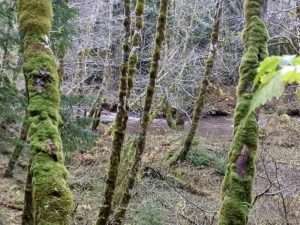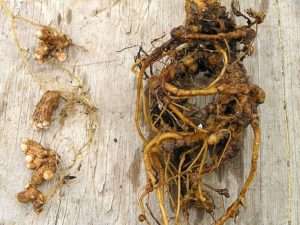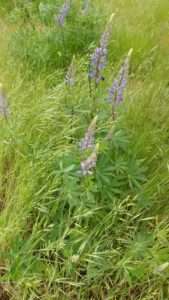 When I am teaching my class on Forests, Fire Ecology, and Climate Change, I always start with a basic introduction to how a forest is put together, and how it recovers from a disturbance, whether natural or human-made. We discuss the different stages of succession and what sorts of plants colonize the disturbed area first. And one of the things I mention is that some of these early succession plants fix nitrogen in the soil.
When I am teaching my class on Forests, Fire Ecology, and Climate Change, I always start with a basic introduction to how a forest is put together, and how it recovers from a disturbance, whether natural or human-made. We discuss the different stages of succession and what sorts of plants colonize the disturbed area first. And one of the things I mention is that some of these early succession plants fix nitrogen in the soil.
Red alder (Alnus rubra) is one of the most important nitrogen fixers in Pacific Northwest forests. This fast-growing deciduous tree is one of the first to sprout a few years after a disturbance, and it is a common sight not only in younger forests but along riparian zones and other boundary areas as well. Because it may delay the growth of conifers through its aggressive spread over open areas, timber companies routinely kill red alder with pesticides so that their Douglas fir and other commercial trees can establish themselves more quickly. This may be a short-sighted decision, however.
How Plants Fix Nitrogen in the Soil

As one of several nitrogen-fixing plants, red alder has evolved to adapt to soils which has low nitrogen levels. This element is key to healthy plant growth, and if the alder can’t find it in the ground, then it must source it elsewhere. And since our atmosphere is about 78% nitrogen, it’s not surprising that some species found ways to exploit this valuable resource. But they couldn’t do it alone.
Enter Frankia. This genus of bacteria is the alder’s secret solution to getting at atmospheric nitrogen. Certain species of Frankia make their home within growths on the alder’s roots known as nodules. In return for this safe shelter, the bacteria convert nitrogen breathed in by the tree to ammonia using an enzyme known as nitrogenase.
Of course, as long as the alder is alive the nitrogen-as-ammonia remains locked within the nodule. However, these trees usually only live a century or so at the most, and their decay allows the nitrogen to be released into the nearby soil. As a naturally regenerating forest matures and the early succession red alder trees die back, their nitrogen stores help to nourish later succession conifers and other plants.
Other Nitrogen-Fixing Plants of the Pacific Northwest
 There are a number of other native plants in the Pacific Northwest that use the same process to fix nitrogen in the soil. Most of them are generally shorter-lived than red alder, and so while they may not spend as much time soaking up nitrogen, they return it to the soil through their decay more quickly. Some of these are legumes, particularly several species of Lupinus including L. albicaulus, L. albifrons, L. latifolius, L. laxiflorus, L. lepidus, L. polyphyllus, L. rivularis, and L. sulphureus, along with some species of Lathyrus, Lotus, and Vicia. Some non-legume native plants fix nitrogen as well, including but not limited to several other Alnus species, Ceanothus, Shepherdia, Dryas, and Myrica.
There are a number of other native plants in the Pacific Northwest that use the same process to fix nitrogen in the soil. Most of them are generally shorter-lived than red alder, and so while they may not spend as much time soaking up nitrogen, they return it to the soil through their decay more quickly. Some of these are legumes, particularly several species of Lupinus including L. albicaulus, L. albifrons, L. latifolius, L. laxiflorus, L. lepidus, L. polyphyllus, L. rivularis, and L. sulphureus, along with some species of Lathyrus, Lotus, and Vicia. Some non-legume native plants fix nitrogen as well, including but not limited to several other Alnus species, Ceanothus, Shepherdia, Dryas, and Myrica.
There are some well known non-native nitrogen fixers. White clover (Trifolium repens) is popular in gardening and other agriculture as a cover crop, as is red clover (Trifolium pratense). Various other members of the pea family (Fabaceae), such as common vetch (Vicia sativa) and birdsfoot trefoil (Lotus corniculatus) have also been introduced as livestock forage and nitrogen fixing. While these are not as aggressive as some particularly invasive plants, if you have the opportunity to plant native nitrogen fixers, go with those instead. If you’re outside the Pacific Northwest, contact your closest native plant nursery or Native Plant Society for help finding appropriate species for your location.
